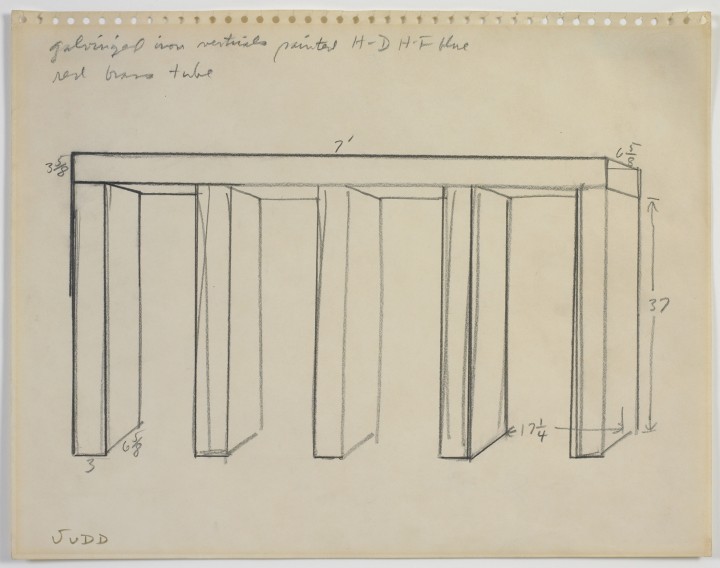
Figure 1. Donald Judd, Untitled, 1967
Graphite on paper, 10 3/4 x 13 1/4 inches (27.3 x 33.7 cm)
Art © Estate of Donald Judd/Licensed by VAGA, New York, NY
The Porous Practice of Drawing:
System, Seriality, and the Handmade Mark in Minimal and Conceptual Art
by Meredith Malone
The exhibition Notations: Contemporary Drawing as Idea and Process presents drawings produced by seminal American artists associated with Minimal, Postminimal, and Conceptual art, as well as a selection of works by artists of subsequent generations who continue to engage with the aesthetic strategies and procedures of their predecessors.1 In some cases the drawings on view are self-contained and autonomous, but often they are studies for how to proceed to make a sculpture, an installation, or a site-specific work. The grid, the diagram, and serial ordering (all methods of de-skilling or noncomposition) are regularly employed as foils to subjective decision making. Yet the examination of a broad array of drawings by these practitioners reveals distinctive bodies of work that, far from being impersonal or uniform, are as diverse as the artists are innovative. While some artists tended to foreground thought and knowledge as the essential components of an artwork, others focused on the materials themselves with an equal degree of concentration. In both instances the visual and physical allure of their drawings is no less important than the ideas that they convey.
Central to the exhibition is the paradoxical compatibility between the use of a priori systems and the individual touch of the artist in an artistic environment that embraced an antiemotive “serial attitude” as something akin to an ethos.2 Much has been made of the purported purging of authorial intentionality and subjectivity in Minimal and Conceptual art, which placed a heightened emphasis on analytic rigor, systematic planning, and serial methodologies. This move is often characterized as a “cool” reaction to the “hot” psychologically transparent practices and rhetoric of heroic individualism associated with modernist abstraction in the United States in the post–World War II era.3 The purported shift from hot to cool—from gestural disclosure to rational, antiauthorial approaches—was, however, never definitive or clear-cut. Drawing, a medium long associated with both the activity of ideation and the manual act of creation, played a central role in attempts by artists associated with the process-based and conceptually rigorous practices of Minimal and Conceptual art to open up established understandings of aesthetic production as well as a generative site for the ongoing negotiation of the relationship between subjective and objective approaches, between touch and measured distance. Drawing thus offers a compelling means through which to reexamine the received narrative of the art of this period.
Artists engaged in a variety of strategies and agendas—including Dan Flavin, Eva Hesse, Barry Le Va, and Sol LeWitt—readily embraced drawing’s salient attributes—its mobility and elasticity, its economy and antimonumental character, its exploratory nature, and its facility for acting as a mediator, translating abstract concepts into form—to produce works that are notational, diagrammatic, and reductive. Often small in scale, delicate, playful, and highly nuanced, these drawings suggest a level of intimacy and direct encounter with the artists’ thoughts and intentions that is less readily apparent in their work in other mediums. Drawing is approached here as a powerful if underrecognized lens through which to explore the productive tensions between rational calculation and subjective expression, concept and material form, and precision and disorder that animate much of the work on view in this exhibition.
Industrial Fabrication / Individual Notation
Employing basic forms, industrial materials, and serial repetition, artists associated with Minimalism, such as Donald Judd and Dan Flavin, sought to free art from symbolic emotional content and pretensions about its transcendent quality. While the established narrative of Minimalism emphasizes an obscuring, even an erasure, of the artist’s hand through the use of industrial fabrication and readymade materials, the preparatory and working drawings (necessities given that their art objects were fabricated industrially) produced by these artists reintroduce the hand into the movement’s legacy.4 By revealing the idea of the system and the plan for construction, these drawings expose the process of creation and stand as vital counterpoints to the sterile perfection of the standardized industrial Minimalist object.
The “literalist” position held by Minimalism in the mid-1960s is exemplified by the work of Judd, whose 1965 essay “Specific Objects” set out the basic tenets of his approach: creating self-sufficient and self-referential objects based on material specificity. Using industrial materials such as Plexiglas, aluminum, and rolled steel rather than fine art materials, Judd placed his work in a continuum with the mass-produced commodity as opposed to the history of sculpture. The artist employed drawing to work out structure, proportion, and spatial relationships for sculpture but never considered his works on paper as anything other than technical instructions, a type of language used to convey information for the execution of standardized three-dimensional forms. Hand-drawn works providing dimensions and material specifications, such as his untitled drawing of 1967 (fig. 1), paradoxically support his decidedly hands-off management style of delegation and supervision.5
While Judd understood his working drawings as necessary supporting material for the creation of his serial sculptural works, drawing played a more essential role in the practice of his Minimalist contemporary Dan Flavin. The artist drew incessantly and for a variety of purposes: to notate an idea or create working drawings for artworks in other media; to make quick renderings of nature; to execute finished presentation drawings for sale; and to commission “final finished diagrams”—drawn in colored pencil on graph paper by his wife, son, and studio assistants—which acted as records of his site-specific fluorescent light installations.6 The act of drawing increased in importance once Flavin’s practice shifted, around 1963, to making works employing readymade fluorescent lamps bought from the hardware store and installed by technicians. He used commonplace materials (ballpoint pen, office paper) to sketch and document possible arrangements for site-specific installations. Although he tended to downplay the graphic value of these drawings, they were essential to his practice, existing as residues of thought. Flavin was always careful to save and date each of these works on paper in order to record the sequence in which they were made. Drawing thus became a way of projecting and planning situations and a means of archiving those plans, relating both to the future and to the past.7
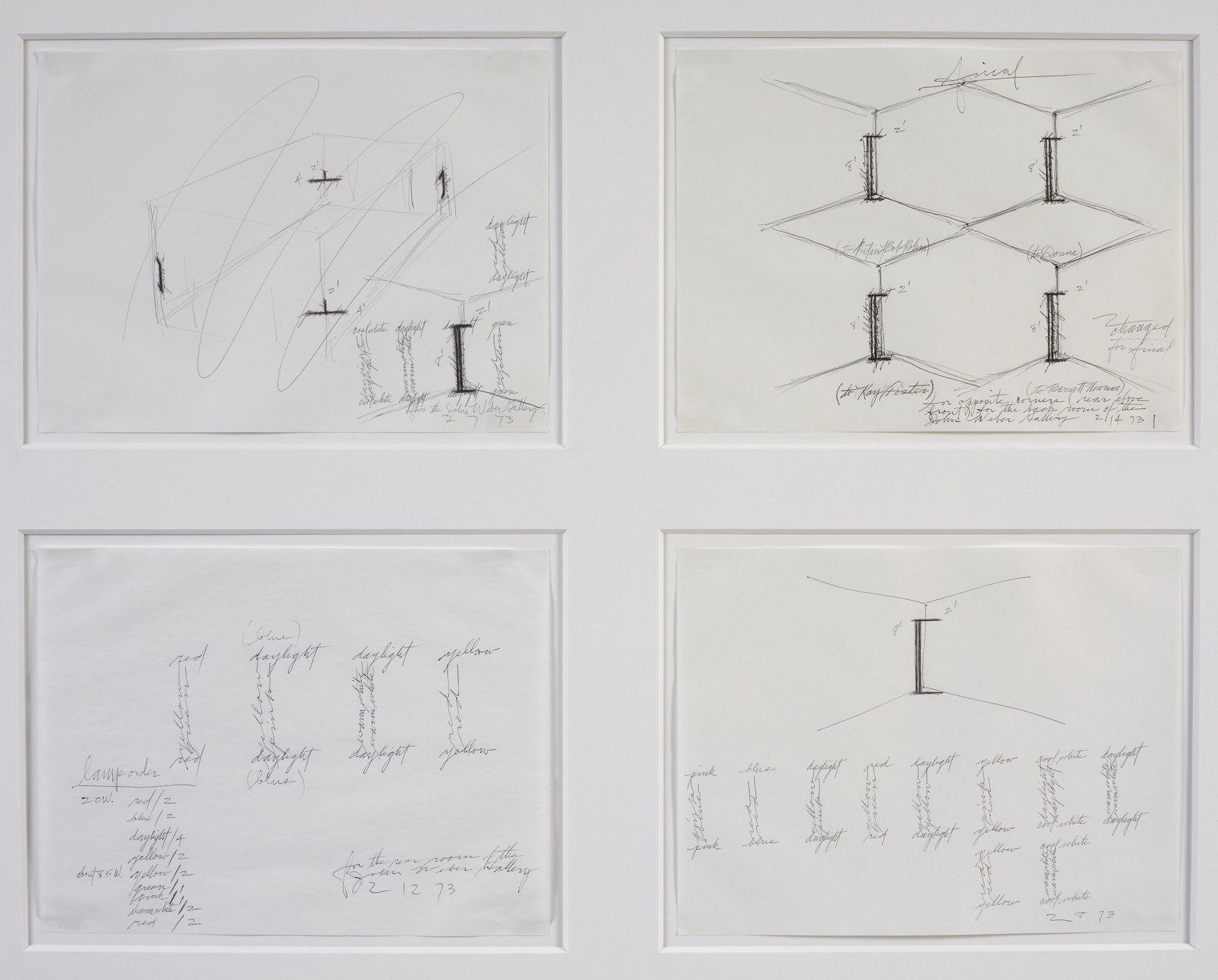
Figure 2. Dan Flavin, Four drawings for the John Weber Gallery, Feb. 7, 1973; Feb. 8, 1973; Feb. 12, 1973; Feb. 14, 1973, 1973
Ballpoint pen on typing paper, 4 sheets, each 8 1/2 x 11 inches (21.6 x 27.9 cm)
© 2012 Stephen Flavin / Artists Rights Society (ARS), New York
Four Drawings for the John Weber Gallery, Feb. 7, 1973; Feb. 8, 1973; Feb. 12, 1973; Feb. 14, 1973 (1973; fig. 2) is representative of these working drawings. Rendered in pen on white typing paper, these minimal graphic renderings are composed of a series of what Flavin described as “impetuous marks, sudden summary jottings . . . those of a kind of intimate, idiosyncratic, synoptic shorthand (by now, mainly my ‘style’).”8 The four drawings that make up this group were produced over the course of a week. Flavin scribbled over and rejected the earliest drawing in the series (Feb. 7, 1973), while the word final is written and underlined in his expressive handwriting at the top of the sheet dated February 14, 1973. Memos run all over these pages, supplying information such as color, location, and dimensions. Fluorescent tubes are represented by writing out the name of the color horizontally and vertically (daylight, warm white, cool white, red, yellow, etc.), literally drawing with words. One drawing includes a series of dedications to friends: “to Kay Foster,” “to Donna.” Personal dedications were common in Flavin’s practice, referring not only to friends but also to art historical figures such as Barnett Newman and to political events, as in a 1970s drawing dedicated “to the young woman and men murdered in Kent State and Jackson State Universities and to their fellow students who are yet to be killed.” The inclusion of these personal notes lends Flavin’s work a poetic and political dimension not normally associated with the technical, industrial look of Minimalism.
Conceptual / Experiential
Drawing proved less well suited to the overall goals of other artists associated with Minimalism, for whom the medium gave undue preference to the conceptual over the physical and temporal experience of their sculptural work and the ambiguities of that experience. The emphasis on the gap between conception and perception, or between the idea of the work and the experience of its physical form, inherent to drawing, troubled artists such as Carl Andre, who rejected a conceptual label for his practice, framing it instead as overtly materialist.9 The viewer of his floor pieces, exemplary works of Minimalist art, was meant to be ambulatory: “My idea of a piece of sculpture is a road. That is, a road doesn’t reveal itself at any particular point or from any particular point. . . . Most of my works—certainly the successful ones—have been ones that are in a way causeways—they cause you to make your way along them or around them or to move the spectator over them.”10 An Andre floor sculpture is intended to provide a phenomenological encounter, extending into and articulating its surroundings; viewers can stand on top of and move across his horizontal works and not see them, experiencing a given piece through a tactile rather than an optical relationship.
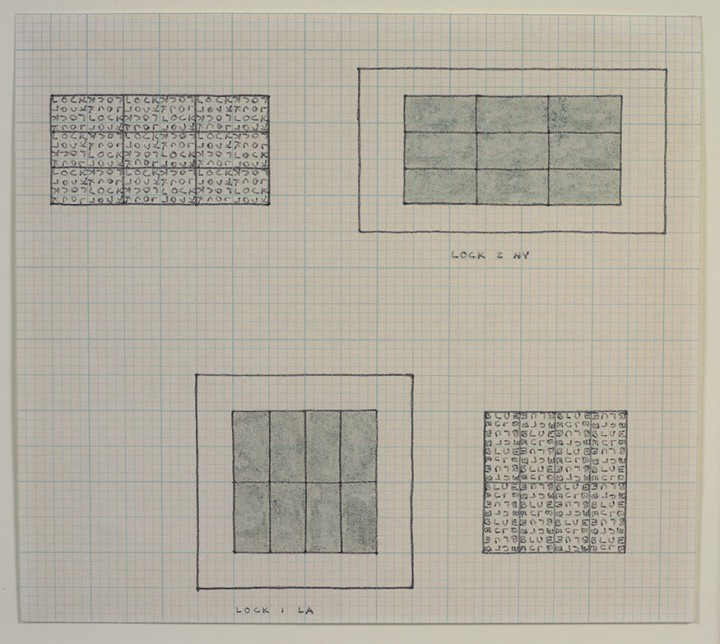
Figure 3. Carl Andre, Blue Lock, 1966
Colored ink and felt-tip pen on graph paper, 8 3/4 x 9 3/4 inches (22.2 x 24.8 cm)
Gift of Sally and Wynn Kramarsky, The Museum of Modern Art, New York
Art © Carl Andre/Licensed by VAGA, New York, NY
Given the importance that he placed on both the materiality of the sculptural object and the viewer’s spatial encounter with it, Andre was resistant to resolving a given work in a single, fixed image, be it in the form of a preparatory drawing or an installation photograph. In Blue Lock (1966; fig. 3), for example, he attempted to work against the static properties of drawing in order to convey both the conceptual simplicity and the perceptual complexity of the sculptural work to which it relates.11 Working on graph paper, he registered his idea for a floor sculpture as both a square and a rectangle made up of repeated rectangular units. In two adjacent grids he filled the regimented squares of the paper with handwritten letters that spell out the words lock and blue. Written in all caps, the letters run in multiple directions, suggesting manifold views—the viewer is compelled not only to read across the grids but also to turn the sheet around to view it from diverse vantage points.12
Richard Serra similarly grappled with the disjunction between the fixed nature of the preparatory sketch and the physical experience of his large-scale sculptural work in space and time. Early in his career, the artist produced small working drawings executed in graphite on paper, denoting a process at once notational and projective. Untitled (Preliminary Drawing for L.A. County Museum) (1971; fig. 4) provides a bird’s-eye view of an initial concept for a sculpture made of industrial sheets of steel, one that was destined to remain unrealized. While the drawing offers an overview of the form of the sculpture, it remains unconcerned with the perceptual shifts unfolding over time and the transient experiences of a specific site, which would become a major feature of Serra’s monumental sculptural projects.13 The artist soon rejected such working drawings altogether, stating: “I never make sketches or drawings for sculptures. I don’t work from an a priori concept or image. Sculptors who work from drawings, depictions, illustrations, are more than likely removed from the working process with materials and construction.”14
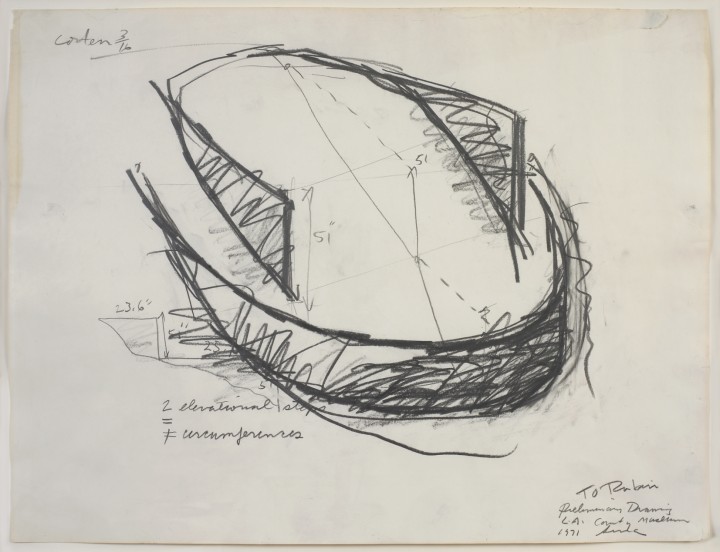
Figure 4. Richard Serra, Untitled (Preliminary Drawing for L.A. County Museum), 1971
Graphite on paper, 17 3/4 x 23 1/2 inches (45.1 x 59.7 cm)
© 2012 Richard Serra / Artists Rights Society (ARS), New York
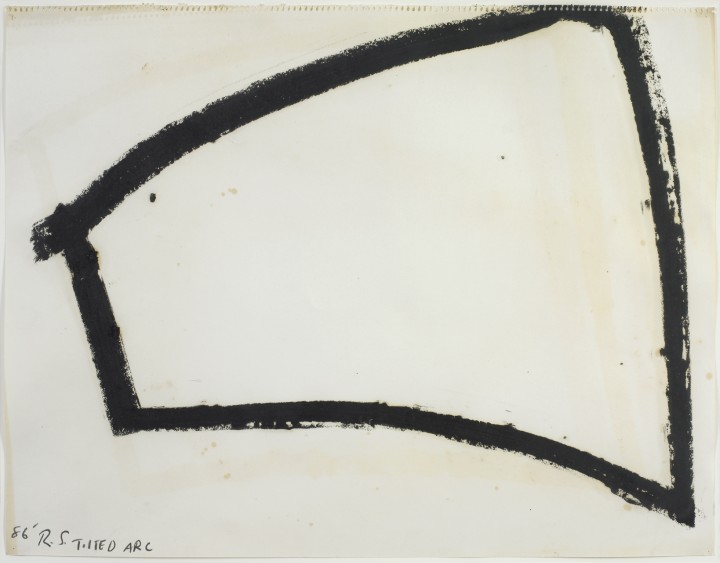
Figure 5. Richard Serra, Titled Arc, 1986
Oil crayon on paper, 19 x 24 1/2 inches (48.3 x 62.2 cm)
© 2012 Richard Serra / Artists Rights Society (ARS), New York
Drawing would remain a fundamental practice for Serra nevertheless. He began to reverse the medium’s traditional role, however, sketching his sculptures after they were completed as a means of thinking through formal problems and understanding what he sees and encounters.15 With Tilted Arc (1986; fig. 5), one in a series of sketches in notebooks made with oil crayon, drawing becomes a means to revisit a piece, in this case his work of public art of the same title constructed in 1981 at Federal Plaza in New York. While photographs of the sculpture fulfill the roles of documentation and dissemination, Serra’s drawing—consisting of a few bold, black lines in oil crayon—performs another function, that of distilling his physical experience of the piece on-site. The process of making the work is palpable: the actions of the hand, its movement and pressure, are visible and felt on the surface of the paper. Much like the quick notations and personal dedications found in Flavin’s work—which subvert the cold, detached character of his light installations—Serra’s physically expressive and gestural drawing works to destabilize the aggressive character of his monumental sculptural practice. Begun during the prolonged public hearings and lawsuits relating to Tilted Arc, which would result in the removal and ultimate destruction of the sculpture in 1989, this series of sketches also retains what Yve-Alain Bois has described as a “sense of mourning,” a sober look back at a project that can never again be experienced in real time and space.16
Prescribed Procedures / Amorphous Results
By the late 1960s, the emphasis on materiality and physicality of experience, evinced in both Andre’s and Serra’s distinctive approaches to drawing and sculpture, was pervasive. Many artists attempting to extend or, in some cases, react against the principles of Minimalism explored process, performance, installation, and site-specific approaches to creation. Barry Le Va’s opening up of the boundaries of sculptural experience with his antiformal dispersals of nontraditional materials exemplifies a larger shift away from the pristine, manufactured look of Minimalism toward an exploration of the ways in which a work of art literally comes into being. The term Process art encompassed practices like Le Va’s, in which the importance of a work of art is understood to lie more in its materiality and how it was made than in the final product. Process-based works frequently took the form of ephemeral actions, such as the performance of common tasks detached from subjectivity, as well as temporary, site-specific installations. Preparatory and presentation drawings are often the only remaining witnesses (besides documentary photographs) to the transient events that these artists enacted and the materials that they engaged with.
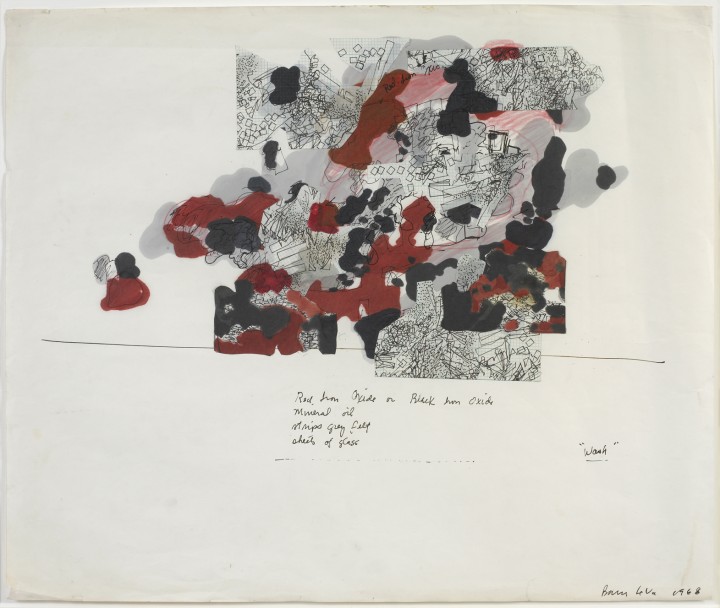
Figure 6. Barry Le Va, Wash, 1969
Ink on graph paper mounted on paper, 18 1/2 x 22 inches (47 x 55.9 cm)
© 2012 Barry Le Va
In 1966 Le Va began producing his distribution pieces, floor-based installations that rejected traditional notions of a strictly ordered composition. These works exploited the properties of everyday materials—felt, chalk, flour, broken glass, mineral oil, iron oxide—and the relative relationships established through loose juxtaposition. Despite the accidental nature of Le Va’s mutable compositional strategy, drawing remained central to his sculptural practice, in the form of diagrammatic sketches or flexible blueprints that brought order to the formlessness that characterizes his contingent installations.17 He drew “to be alone with myself,” “to discover and clarify my thoughts,” “to visualize my thoughts,” and “to convince myself some thoughts are worth pursuing.”18 Certainly one can detect a sense of disegno in his conception of drawing—that is, a projective and idealist belief in the medium as uniquely capable of revealing the artist’s mind at work and exposing the mechanism of the creative process. Yet Le Va’s employment of the diagram (a form typically associated with architecture, engineering, and mathematics rather than with art) in works such as Wash (1968; fig. 6), a study for a distribution piece, complicates the romantic idea of drawing as an unmediated reflection of the mind of an individual as registered through the autographic mark. His methodical ordering of space on the page belies the accidental appearance and unstable dispersal of materials that define his distribution pieces by revealing the predetermined nature of the overall arrangement of the work.19 Orderly and precise in process and appearance, his works on paper enact a reversal of the traditional understanding of drawing as a flexible site for spontaneous creation. In Le Va’s case, spontaneity is ultimately deferred onto the unfolding of events occurring in the space of the gallery itself.
Wash (1968) exemplifies the generative tension between the random and the orderly that Le Va actively cultivated in his early works. The drawing includes passages of graph paper on which the artist first mapped out the distribution of pieces of felt and shards of glass. Le Va and many of his contemporaries frequently used graph paper, not so much for its look as for its suitability for the transfer of ideas into form. As the artist Mel Bochner reasoned, “graph paper reduces the tedious aspects of drawing, and permits the easy and immediate alignment of random thoughts into conventionalized patterns of reading and forming.”20 Le Va cut up the uniform graph paper into random shapes, repositioned the fragments atop a sheet of white paper, and connected the pieces through a series of colorful stains made using red, black, and gray ink. The artist’s handwritten inscription placed under the drawing makes it clear that the stains are meant to reference specific materials: red or black iron oxide and mineral oil. This diagram was apparently never realized in sculptural form but is related to a series of impermanent installations that Le Va would complete at the Walker Art Center in Minneapolis in 1969. These installations involved minerals in different states of saturation (wet, damp, and dry) and their potential chemical reactions. Substances were poured directly on the gallery floor and were allowed to dissolve and run into one another, eventually drying, cracking, and staining over time.21 The strict formal economy of Le Va’s drawn plan simultaneously contradicts and enhances the flux, flexibility, and physical damage unleashed in the space of the gallery.
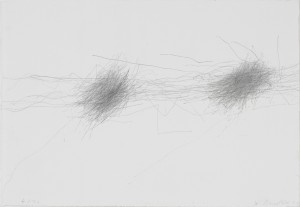
Figure 7. William Anastasi, Untitled (Subway Drawing), 1973
Graphite on paper, 7 5/8 x 11 1/8 inches (19.4 x 28.3 cm)
Mildred Lane Kemper Art Museum, Washington University in St. Louis, Gift of Mr. and Mrs. Gary Wolff, 2011
© 2012 William Anastasi

Figure 8. William Anastasi, Untitled (Subway Drawing), 2009
Graphite on paper, 8 x 11 1/2 inches (20.3 x 29.2 cm)
© 2012 William Anastasi
William Anastasi’s subway drawings (figs. 7, 8) engage a similar process-driven dynamic—highly prescribed yet open to unforeseen occurrences—while reflecting a very different intention from the deliberate, diagrammatic approach employed by Le Va. Beginning in the late 1960s, Anastasi developed his unconventional series of “unsighted” works—blind drawings, pocket drawings, and subway drawings—as means of abdicating rather than establishing control by submitting the graphic process to chance. To create his ongoing series of subway drawings, he sits on a subway train, places a sheet of paper on a board on his lap, takes a pencil in each hand, rests the points on the paper, closes his eyes, dons headphones to block out all ambient sound, and lets the movement of his body in transit determine the composition of each work. Rather than relying on vision, he creates the work by assigning himself a simple task and arbitrary limits: each drawing is produced in the time it takes him to get from point A to point B on the subway and is finished when he gets off the train at a predetermined destination. By drawing blind and incorporating chance, Anastasi subverts the tradition of drawing as a synthesis of vision, knowledge, and manual skill.
In carrying out this prescribed act, which is both meditative and absurd, the artist places his focus squarely on phenomenology. Phenomenological impact became a key aspect in some strains of Minimalist sculptural production in the late 1960s as artists such as Carl Andre, Robert Morris, and Richard Serra were preoccupied not only with the process of production but also with how a work was perceived by the viewer in real time and space.22 These artists often forced the spectator’s body into a confrontation with an object or a visual field as a form of defamiliarization, exhorting viewers to become conscious of their own processes of perception in order to see beyond the prevailing conventions of art. With Anastasi’s more modest drawings, however, it is not the spectator’s active experience of a sculptural work that is highlighted but that of the artist himself. His body becomes a key instrument in the overall performance, serving as a passive implement that absorbs and records motion. Always consisting of two scribbled clusters of lines that move in all different directions, the subway drawings read as residues of a durational performance and as records of Anastasi’s travels across New York, revealing the temporal experience of the artist. Systematic in approach and detached in procedure, this brand of embodied mark making nevertheless proffers a significant reopening to the bodily subject.
Rational / Anti-Rational
Sol LeWitt pushed the process- and systems-based approach to artistic production in still another direction. Rejecting any focus on the performing body of the artist, he elevated the working through of an idea to a position of importance, which he understood as equal to that of the resulting work. Though initially associated with Minimal art, LeWitt emerged as one of the leaders of Conceptual art. In his “Paragraphs on Conceptual Art” (1967), which became in effect a manifesto for the movement, he crystallized a radically divergent move in postwar art toward praxis as idea based: “If the artist carries through his idea and makes it into visible form, then all the steps in the process are of importance. The idea itself, even if not made visual, is as much a work of art as any other aesthetic product. All intervening steps—scribbles, sketches, drawings, failed works, models, studies, thoughts, conversations—are of interest.”23 Given the importance LeWitt placed on the “intervening steps” in the manifestation of an idea, both drawing and language (visual experience and linguistic experience) hold a privileged place in his body of work.
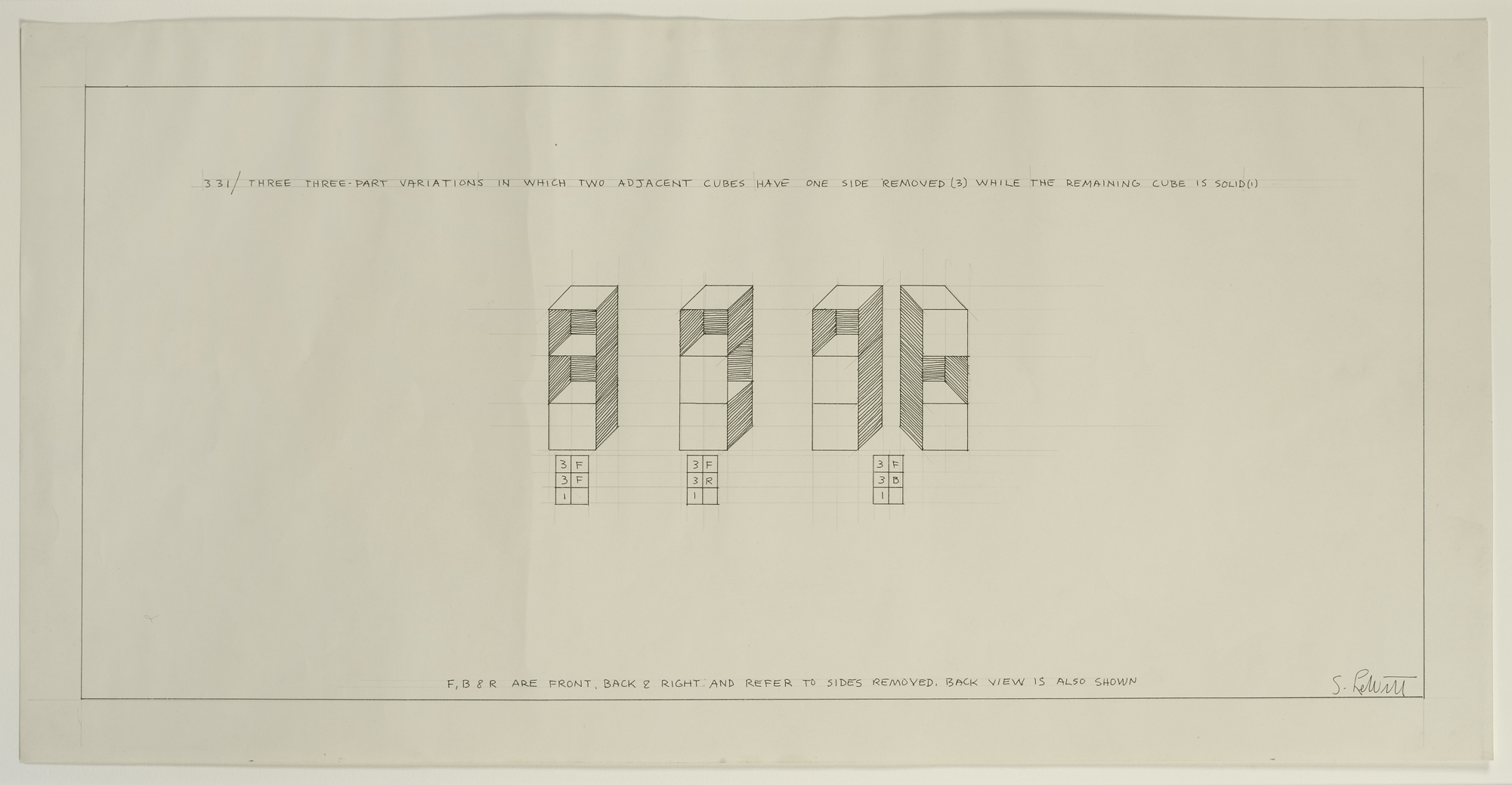
Figure 9. Sol LeWitt, Three-Part Variations on Three Different Kinds of Cubes 331, 1967
Ink and graphite on paper, 11 3/4 x 23 3/4 inches (29.8 x 60.3 cm)
© 2012 The LeWitt Estate / Artists Rights Society (ARS), New York
Three-Part Variations on Three Different Kinds of Cubes 331 (1967; fig. 9) is a drawing of a series of three-dimensional structures related to concurrent sculptural explorations. LeWitt plotted different permutations on three-cube constructions or, as he wrote at the top of the drawing in capital letters: “three three-part variations in which the top and bottom cube have one side removed (3) while the middle cube is solid (1).” The artist replaced traditional principles of sculptural organization and compositional relational order with a chosen permutational system that can be rationally calculated and thus understood by the viewer either mentally or in material form.
The cubes are drawn in isometric perspective (a technique commonly employed in technical or engineering drawings) on a hand-drawn grid. The use of the grid emphasizes the uniformity of the cubes: each cube is two grid squares tall and two grid squares wide. The grid and the technical rendering give the appearance of an ordered sequence intended to provide objective visual information, expressing a universalizing vision of industrial-age perfection based on serial production. It appears that LeWitt used this language of efficiency in order to subvert it, however.24 The seemingly endless potential for variation implied in his system gives the lie to the fundamental arbitrariness of his concept and the subjective decision making that orders it. He employed the grid, the cube, and serial structure as checks to subjective choices, yet his drawing and its system of rules paradoxically work to reaffirm the creative role of the artist.25
Although the serial is commonly associated with the rationalism found in Minimalist works by artists such as Judd, Andre, and Flavin, it always holds within it a relationship to its opposite: the random or antirational. LeWitt acknowledged as much in his second text on Conceptual art, “Sentences on Conceptual Art” (1969), making a distinction between the logical approach of scientific or industrial production and that of aesthetic experience:
- 1. Conceptual artists are mystics rather than rationalists. They leap to conclusions that logic cannot reach.
2. Rational judgments repeat rational judgments.
3. Irrational judgments lead to new experience.
4. Formal art is essentially rational.
5. Irrational thoughts should be followed absolutely and logically.26
LeWitt uses the word irrational loosely in this text. Employed in this context as a means of signaling the polar opposite of rational judgment and sound logic, the term also implies a type of action that is completely beyond human control, a meaning that seems to move outside the bounds of the dichotomy that he strives to set up between the rational and the subjective. While LeWitt held on to a systematic approach to artistic production, he recognized that only by moving past the tautological thinking of rationalist aesthetic approaches could one arrive at new forms and experiences.
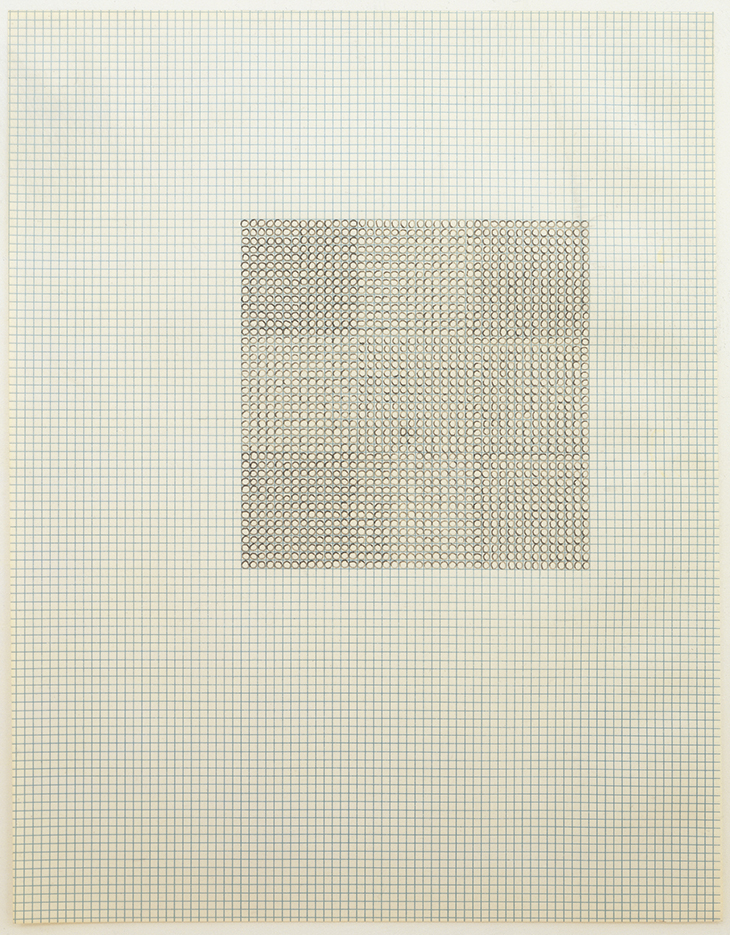
Figure 10. Eva Hesse, Untitled, 1967
Ink on graph paper, 11 x 8 1/2 inches (27.9 x 21.6 cm)
© The Estate of Eva Hesse, Hauser & Wirth Zürich London
Eva Hesse also probed the relationship between order and disorder, between serial methodology and antirational processes, yet her work delineates an opposing limit of this practice. Although she was part of the circle of Minimalist and Conceptual artists who worked and socialized in New York in the 1960s and 1970s, her artistic production is often characterized as Postminimal, a term that acknowledges her move to open up the constrained structures of Minimalism by giving geometric form an organic and bodily dimension. Hesse’s work is notable for the way in which it implicates the body in new ways—the body understood as a psychic site rather than the neutral or passive one of Anastasi’s subway drawings and much Minimalist art. Drawing played a central part in this expansion of boundaries. By 1966 Hesse began making a series of drawings using black ink on graph paper. She worked with the controlled grid, but was equally interested in the potential for accident, embarking on what has frequently been described as a form of compulsive repetition and accumulation. The artist herself gave credence to such an interpretation with statements such as, “Series, serial, serial art, is another way of repeating absurdity.”27 Her untitled drawing of 1967 (fig. 10) is exemplary of this series of works in which the basic element of the circle is repeated over and over to fill in the form of the grid. Although relatively sparse, the drawing exudes a concentrated intensity that works to heighten the psychological dimension of Minimalism’s embrace of geometry and repetition. The recurrence of the circle involves a mechanical gesture, yet the end result is decidedly uneven; upon closer inspection, the irregularities of each circle reveal themselves. Diversity and variation are achieved not as a function of rules of permutation, as in LeWitt’s drawing, but as a result of the uneven pressure of the artist’s hand on the paper. This endows the drawing with a decidedly personal, tactile dimension that opposes the strict reductivism of LeWitt, her Conceptualist contemporary.
Minimal and Conceptual Drawing and its Legacy
Although their approaches and agendas were notably distinct, all the artists discussed here were working through the fallout of a modernist vision of art and society, self-consciously rethinking and challenging established traditions of artistic practice. Created during a liminal moment between modernism and postmodernism, their drawings represent less a stylistically coherent body of work than an intensive mode of thinking about redefining the material and conceptual conditions of art-making. While attempting to move away from the emotive claims of their Abstract Expressionist predecessors, artists associated with Minimal, Postminimal, and Conceptual practices wanted to uphold the freedom of experimentation with form and materials initiated by artists such as Jackson Pollock. The climate of analysis and material experimentation of the 1960s and 1970s in the United States not only addressed the artwork and standards of artistic production but also extended to the critique of institutions, the role of the artist and audience, the dissemination of artworks in the market, and the industrial conditions of modern society.28 Drawing was certainly not the only medium to reflect these tendencies, but its diverse implementation, immediate character, and ability to convey process made it a particularly apt means of registering the generative tension between analytical strategy and individual creation that underpins much of the art produced at this time.
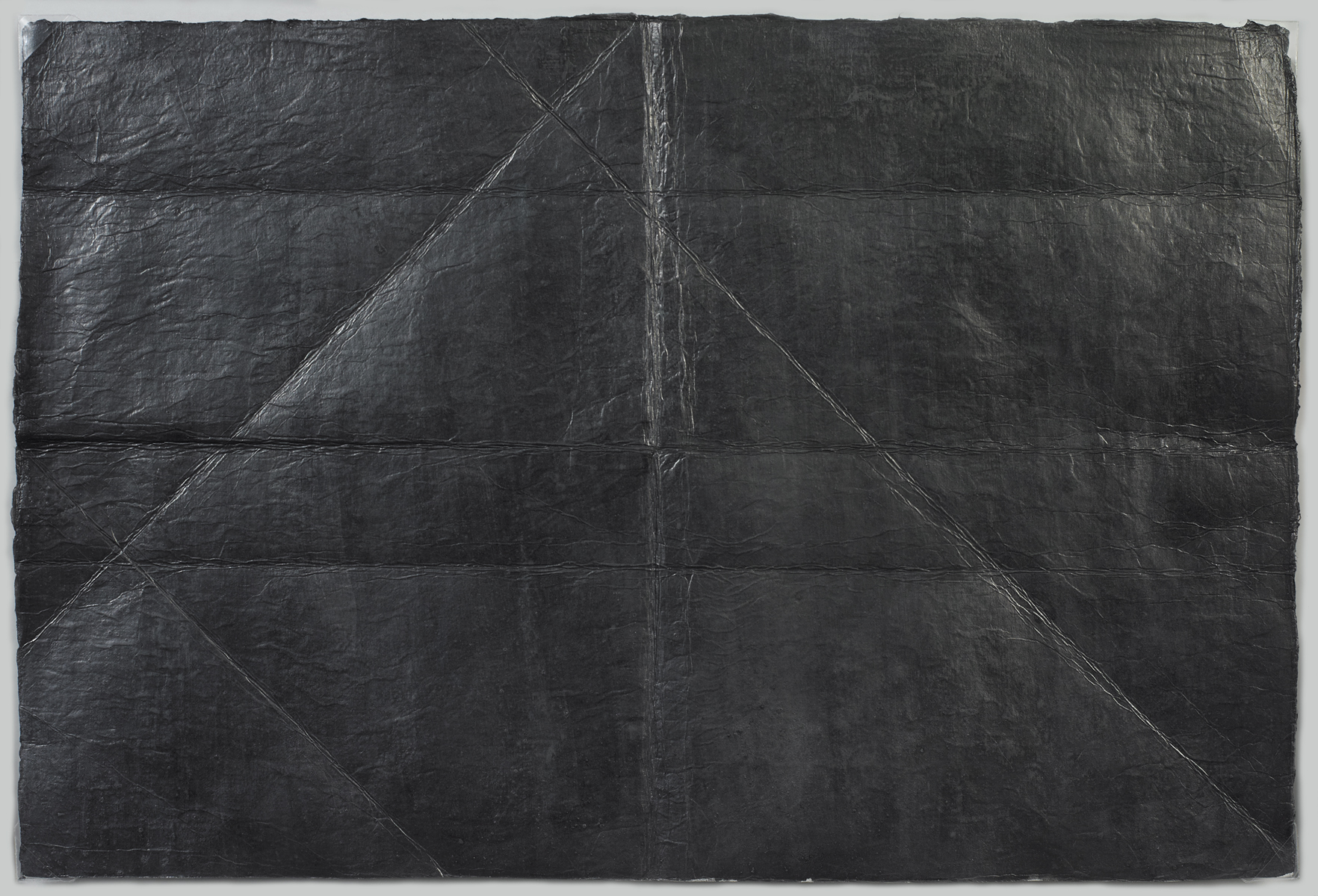
Figure 11. N. Dash, Commuter, 2011
Graphite on paper, 14 3/4 x 9 3/4 inches (37.5 x 24.8 cm)
© 2012 N. Dash
In the four decades since the 1970s, several significant paradigm shifts have reshaped the political and social world in which we live, including the rapid rise of the digital age and an increased global connectedness accompanied by greater mobility, standardization, and homogenization. Art has continued to adapt to these new conditions. Many of the issues that motivated the artistic struggle to work through and against modernist endgames—the idea that art is predicated on a progressive model of invention or the essentialist notion that something like the absolute essence of painting or sculpture exists—are of little interest to subsequent generations of artists.29 They no longer feel compelled to grapple with the rules of such a limited approach; nor are they constrained by postmodernism’s negative and nostalgic appraisal of the modernist past. Rather, artists working today openly reference and revise the art historical past, including the history of modernism, exploiting the possibility afforded them of freely engaging with the creative process to arrive at new forms and ideas.
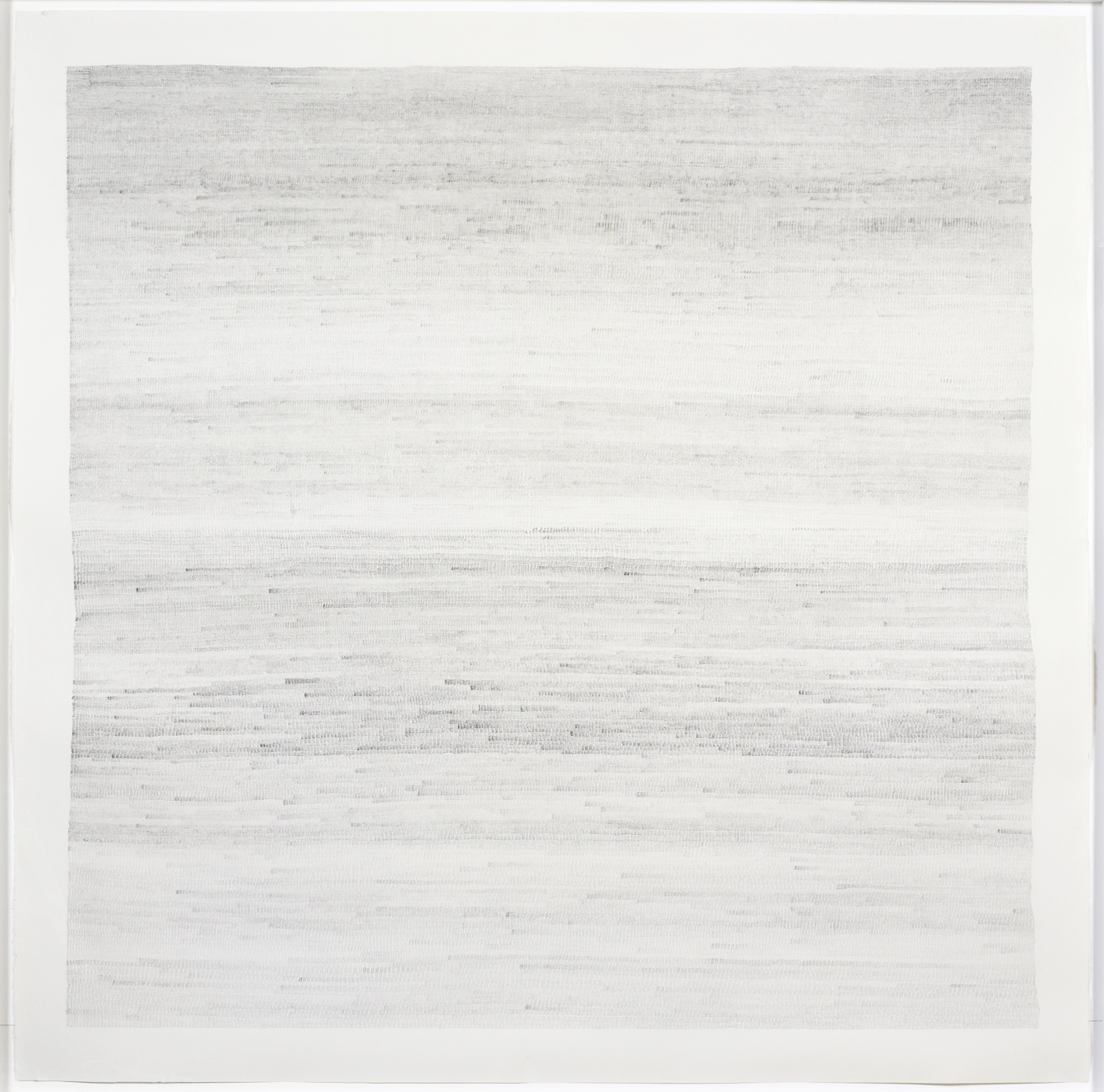
Figure 12. Jill O’Bryan, 40,000 Breaths Breathed Between June 20, 2000 and March 15, 2005, 2000-05
Graphite on paper, 60 x 60 inches (152.4 x 152.4 cm)
© 2012 Jill O’Bryan
The artists N. Dash and Jill O’Bryan, for instance, adopt a range of modernist strategies, including repetitive and serial processes as well as body and performance art, all of which emerged in the 1960s and early 1970s. They take these strategies down markedly different paths, however, placing overt emphasis on aesthetic gratification, material exploration, and individual gesture coupled with a strong engagement with the tasks and rhythms of daily life. Rather than explicitly linking the practice of drawing to large-scale sculptural installations and other conceptual projects—as was the case in the work of Flavin, Serra, Le Va, and LeWitt—both artists embark on highly hermetic forms of creation through which the properties of drawing are probed and developed. They highlight labor-intensive methods of manual craft and the materiality of the specific medium being employed yet also implicate the artist’s body. N. Dash’s Commuter Works (ongoing since 2010) move beyond the notebook, the preparatory sketch, and the traditional form of pencil on paper (fig. 11). Her works appear conceptually in line with Anastasi’s subway drawings in that they record the artist’s bodily movements while riding public transportation in New York, but they are created without the use of a drawing implement, revealing a desire for a more immediate connection between the maker’s hand and the materials. Dash produces these works by folding, rubbing, creasing, and refolding sheets of paper and then applying pigment (graphite or indigo powder) to them by hand in order to highlight the progressive accumulation of wrinkles and marks. Her practice is based less on an exploration of automatic processes, chance occurrences, or a sublimation of the subjective self, as are Anastasi’s subway drawings, and more on an examination of the means by which bodily expression can be embedded into the support materials associated with painting, sculpture, and drawing. Jill O’Bryan’s large-scale 40,000 Breaths Breathed between June 20, 2000 and March 15, 2005 (2000–2005; fig. 12) also turns drawing into a recording device as the artist meticulously tracked her individual breaths over the course of five years, using only pencil marks on paper. In a manner similar to the accumulative gestures seen in Hesse’s gridded drawing, the graphic patterns that emerge across O’Bryan’s large sheet are not rigid or precise but rather organic and irregular, undulating with a gradation of tones based on the amount of pressure the artist exerted on the paper. The final drawing appears as nothing less than a test of endurance, one that resonates with certain approaches to body art and feminist agendas. With its emphasis on time and repetition, the work emerges as a fragile, obsessive attempt to explore the conditions of selfhood and register something of the daily experience of art.

Figure 13. Janet Cohen, San Francisco at New York, 10-8-2000, Mets win 4-0, 2004
Graphite on paper, 9 1/4 x 13 inches (23.5 x 33 cm)
© Janet Cohen, 2004
Janet Cohen’s ongoing practice of meticulously charting popular activities such as the seemingly random events of a baseball game offers yet another variation on this internal and indexical approach to mark making, one that appears to speak simultaneously to the fragmentation of contemporary life and nostalgia for a sense of completeness. Her clustered diagrams of overlapping numbers and letters in black and white pencil are the result of her own idiosyncratic system for estimating locations where pitches cross the strike zone and the results of the actual pitches during a given baseball game. Works such as San Francisco at New York, 10-8-2000, Mets win 4–0 (2004; fig. 13) exist as both abstract representations of these events and as highly individual catalogs of time and thought whose underlying system is understood by the artist alone.
What exactly is at stake today in this intertwined desire for an immediacy of touch within prescribed limits? Marking up a blank piece of paper—experiencing a concrete and immediate way of making art within an evolving digital landscape that often removes us from experiencing “the real” and ourselves—appears to offer itself as an inherently human activity. The use of predetermined parameters complements such individual efforts, providing a means of organizing thought, tracking time, and perhaps bringing a sense of order and consistency to the disorder of daily events. Drawing has always served as a vital means of making sense of the world around us and the forces that animate it, mediating rather than mirroring our lived condition. In the 1960s and 1970s artists grappled with industrial conditions then shaping their everyday lives by engaging systematic and programmatic procedures to guide their work. In many instances, the pronounced engagement with seriality and repetitive marking, charting, and diagramming offered a means not of adopting the rational logic of industry but of highlighting art’s potential escape from it. It seems apt in today’s contemporary climate of ongoing upheaval and perpetual advancement of digital technologies that the desire to draw, to mark, to track is embraced by artists who, much like their historical predecessors, seek to expand the capacities for invention while working to regain a sense of human experience.
Notes
1. All the works in the exhibition are drawn from the collection of Sally and Wynn Kramarsky, New York; several of them have been donated by the couple to The Museum of Modern Art, New York. Over the past few decades, the Kramarskys have amassed a collection that provides an impressive overview of canonical Minimal, Postminimal, and Conceptual art, while continuing to collect works by emerging artists whose work is in line with this core aesthetic.
2. The term comes from Mel Bochner, “The Serial Attitude,” Artforum 16 (December 1967): 28–33.
3. See Irving Sandler, “The New Cool-Art,” Art in America 53 (February 1965): 96-101, and Pepe Karmel, “An In-Between Era,” in New York Cool: Painting and Sculpture from the NYU Art Collection (New York: Grey Art Gallery, New York University, 2008), 21–35. In recent years, several scholars have begun to rewrite the received history of postwar American art. See, for example, Catherine Craft, An Audience of Artists: Dada, Neo-Dada, and the Emergence of Abstract Expressionism (Chicago: University of Chicago Press, 2012).
4. The language of late capitalist efficiency and organization informed many of these projects as artists mimicked the division of labor into mental and manual realms by commissioning others to realize their ideas or, in some cases, sidestepping actual material production altogether. For an in-depth analysis of the relationship between artistic production, labor, and the shifting socioeconomic context in 1960s America, see Helen Molesworth, Work Ethic (Baltimore: Baltimore Museum of Art, 2003), and Julia Bryan-Wilson, Art Workers: Radical Practice in the Vietnam War Era (Berkeley: University of California Press, 2009).
5. Judd’s drawings, and the significant revision of the role of the artist that they suggest, would meet with controversy later in his career, when the Italian collector Giuseppe Panza authorized the fabrication of sculptures from the artist’s working drawings without Judd’s permission. Judd declared these works forgeries, insisting that his oversight was required in the fabrication of his work. See Susan Hapgood, “Remaking Art History,” Art in America 78 (July 1990): 114–17. See also Molesworth, Work Ethic, 163.
6. Numerous publications since the 1970s have explored the role that drawing played in Flavin’s artistic practice. See Emily S. Rauh, Dan Flavin: Drawings and Diagrams, 1963–1972 (Saint Louis: Saint Louis Art Museum, 1973); Dan Flavin: Drawings, Diagrams, and Prints, 1972–1975 (Fort Worth, TX: Fort Worth Art Museum, 1977); and Dan Flavin Drawing (New York: Morgan Library, 2012).
7. Briony Fer, “Nocturama: Flavin’s Light Diagrams,” in Dan Flavin: New Light, ed. Jeffrey Weiss (Washington, DC: National Gallery of Art, 2006), 46.
8. Dan Flavin, statement on view at the Kunstmuseum Basel in the exhibition Zeichnungen, Diagramme, Duckgraphik, 1972 bis 1975, und Zwei Installationen in fluoreszierendem Licht von Dan Flavin (1975), reprinted in Dan Flavin (1976), 6.
9. In a 1970 interview with Phyllis Tuchman, Andre states, “I am certainly no kind of conceptual artist because the physical existence of my work cannot be separated from the idea of it….My art springs from my desire to have things in the world which would otherwise never be there.” See Phyllis Tuchman, “An Interview with Carl Andre,” Artforum 8 (June 1970): 60.
10. Andre, ibid., 57.
11. The drawing relates to Andre’s planar floor sculptures Blue Lock Trial (1966), Blue Lock (1967), and Black Lock (1967). The latter two works have since been destroyed.
12. Christine Mehring provides a compelling reading of this drawing. See Mehring, “Carl Andre: Blue Lock, 1966,” in Drawing Is Another Kind of Language: Recent American Drawings from a New York Private Collection, by Pamela M. Lee and Christine Mehring (Cambridge, MA: Harvard University Art Museums, 1997), 28–29.
13. Yve-Alain Bois, “Descriptions, Situations, and Echoes: On Richard Serra’s Drawings,” in Richard Serra: Drawings, Zeichnungen, 1969–1990 (Bern, Switzerland: Bentelli, 1990), 17.
14. Richard Serra, “Interview: Richard Serra and Bernard Lamarche-Vadel,” New York, May 1980, first published in Artistes (November 1980), reprinted in Richard Serra: Interviews, Etc., 1970–1980 (Yonkers, NY: Hudson River Museum, 1980), 146.
15. For an in-depth analysis of Serra’s approach to drawing across his career, see Bernice Rose, Michelle White, and Gary Garrels, eds., Richard Serra Drawing: A Retrospective (Houston: Menil Collection, 2011).
16. Bois, “Descriptions, Situations, and Echoes,” 28.
17. Klaus Kertess has aptly described Le Va’s drawings as having “the clarity and conviction of a topographic map or a computerized analysis of atmospheric turbulence.” See Klaus Kertess, “Between the Lines: The Drawings of Barry Le Va,” in Barry Le Va, 1966–1988 (Pittsburgh: Carnegie Mellon Art Gallery, 1988), 27.
18. Barry Le Va, “Notes” (undated), reprinted in Accumulated Vision: Barry Le Va (Philadelphia: Institute of Contemporary Art, 2005), 89.
19. Ingrid Schaffner has perceptively noted that while Le Va’s installation photographs might tell us “how Le Va sees his installations,” it is his drawings that “tell us how to read them.” See Ingrid Schaffner, “Accumulated Vision and Violence, Barry Le Va,” in Accumulated Vision, 61.
20. Mel Bochner, “Anyone Can Learn to Draw,” press release for Drawings, Galerie Heiner Friedrich, Munich, 1969, reprinted in Bochner, Solar System & Rest Rooms: Writings and Interviews, 1965–2007 (Cambridge, MA: MIT Press, 2008), 61.
21. Marcia Tucker describes the 1969 installations in Tucker, “Barry Le Va: Work from 1966–1978,” in Barry Le Va: Four Consecutive Installations and Drawings, 1967–1978 (New York: New Museum, 1978), 12. For photographs of the installation, see ibid., 24, 25.
22. See particularly Robert Morris’s series of essays, “Notes on Sculpture” (February 1966) and “Notes on Sculpture, Part II” (October 1966), reprinted in Continuous Project Altered Daily: The Writings of Robert Morris (Cambridge, MA: MIT Press, 1993).
23. Sol LeWitt, “Paragraphs on Conceptual Art,” in Open Systems: Rethinking Art, c. 1970, ed. Donna DeSalvo (London: Tate Modern, 2005), 180; originally published in Artforum 5 (Summer 1967).
24. James Meyer, Minimalism: Art and Polemics in the Sixties (New Haven, CT: Yale University Press, 2001), 187.
25. In the 1960s LeWitt was attracted to the cube and the square as “grammatical devices from which the work may proceed.” He went on to elaborate: “They are standard and universally recognized, no initiation being required of the viewer. . . . The use of a square or cube obviates the necessity of inventing other forms and reserves their use for invention.” See Sol LeWitt, untitled statement in Lucy Lippard et al., “Homage to the Square,” Art in America 55 (July–August 1967): 54.
26. LeWitt, “Sentences on Conceptual Art,” in Sol LeWitt: Critical Texts, ed. Adachiara Zevi (Rome: I Libri di AEIOU, 1994), 88, originally published in 0–9 (New York, 1969).
27. Eva Hesse, quoted in Lucy Lippard, Eva Hesse (New York: De Capo, 1976), 96.
28. Josef Helfenstein, “Concept, Process, Dematerialization: Reflections on the Role of Drawings in Recent Art,” in Drawings of Choice from a New York Collection, ed. Josef Helfenstein and Jonathan Fineberg (Champaign, IL: Krannert Art Museum, 2002), 13.
29. Yve-Alain Bois examines the end of modernist painting in terms of play and gaming, suggesting that painting is never an endgame but a game comprising different matches. See Yve-Alain Bois, Painting as Model (Cambridge, MA: MIT Press, 1990), 241–42. Jordan Kantor also takes up Bois’s analogy in her essay “Drawing from the Modern: After the Endgames,” in Drawing from the Modern, 1975–2005 (New York: Museum of Modern Art, 2005), 53–54.
Bio
Meredith Malone
![]()
![]()
